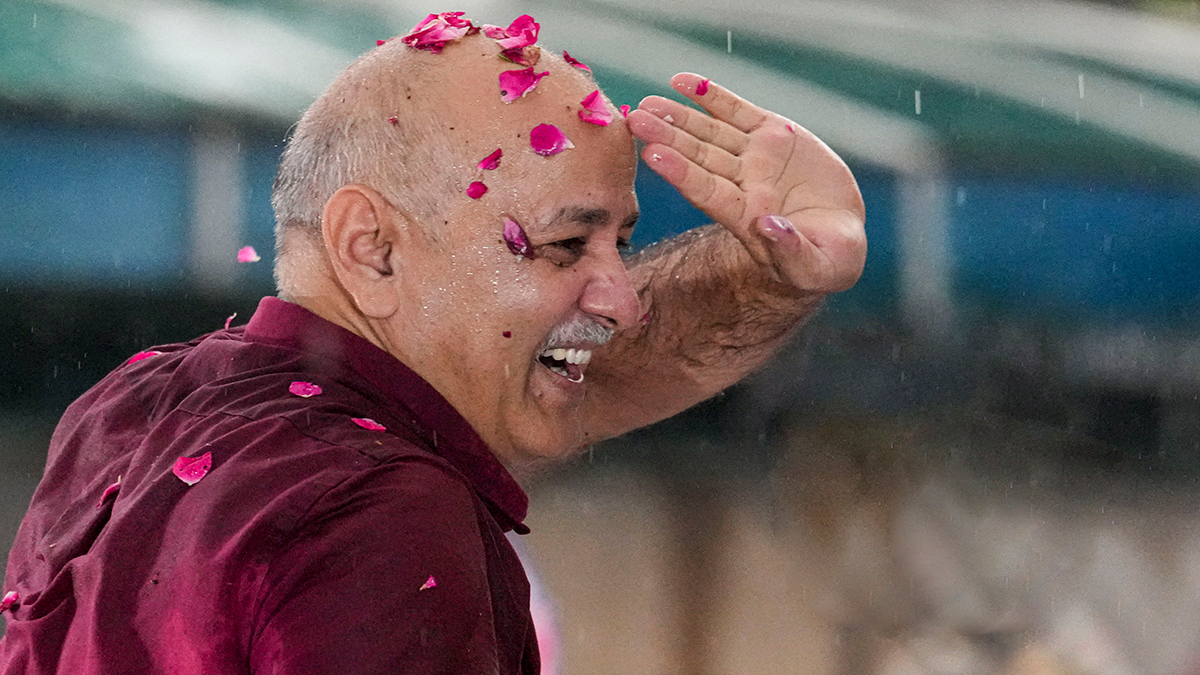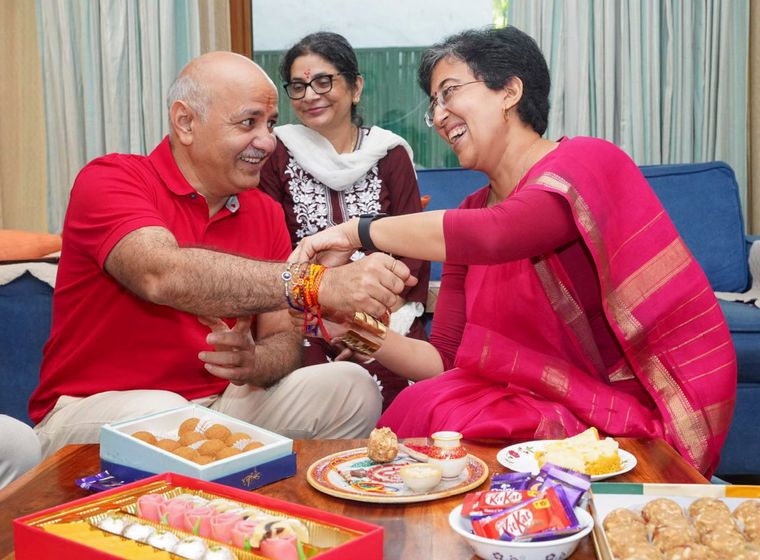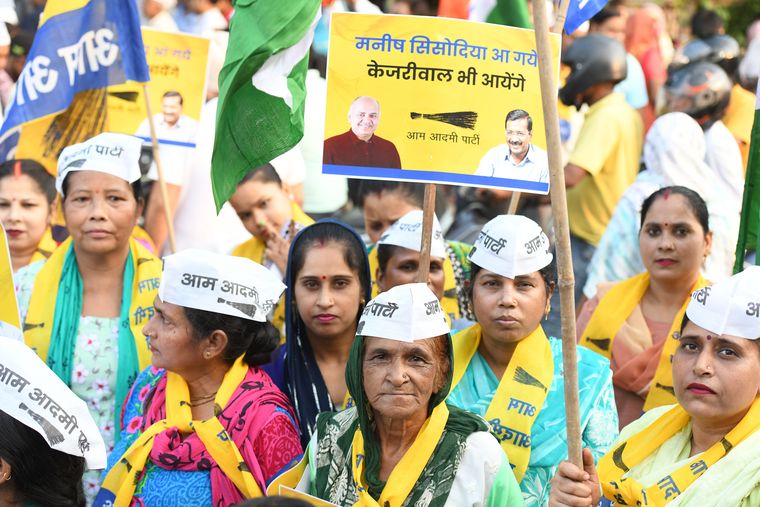It is late in the evening and Kalkaji, one of the prominent neighbourhoods in south Delhi, is teeming with rush hour traffic as people head home from work. Soon, there is a break in the hustle as senior Aam Aadmi Party leader Manish Sisodia steps out from an SUV. Flanked by party workers raising slogans in support and holding aloft his posters, Sisodia, the former deputy chief minister of Delhi, is in the locality to launch his first padyatra after coming out of jail.
The busy crowd slows down to catch a glimpse of the leader who was recently released from jail on bail in the Delhi excise policy case, after 17 months behind bars. A woman pushes her way towards him, “We will never forget what you have done for our children,” she tells him, reminding the crowd about Sisodia’s stint as minister of education.
At regular intervals, volunteers chant the AAP’s new slogan, ‘Manish Sisodia aa gaye, Kejriwal bhi aayenge (Sisodia is back, Kejriwal, too, will follow)’ even as the song, ‘Mera Rang De Basanti Chola’, now featured in most AAP events, plays in the background. As Sisodia finds children lined up with placards welcoming him, he moves through the crowd to acknowledge their presence and gives them his blessings. Sisodia’s most talked about achievement came when he held the education portfolio, transforming the condition of government-run schools in the capital.
Since his release from jail, Sisodia has been on an outreach blitzkrieg through padyatras, meeting a large number of people. “I am overwhelmed to be welcomed as one of their family members,” he told THE WEEK in an exclusive interview. He said his priority was to “reconnect” with the electorate. And rightly so, with the assembly elections in Delhi just six months away.
Sisodia is the tallest leader in the AAP after Chief Minister Arvind Kejriwal, who, too, was arrested in the excise policy case. They go back a long way and Sisodia is Kejriwal’s closest confidant and comrade-in-arms. He was tasked with implementing the AAP’s policies in Delhi, which allowed Kejriwal to focus on the party’s expansion plans. Sisodia’s release has come as a big relief for the AAP.
“With Manish ji’s return, the AAP has become stronger,” said party colleague and Punjab Chief Minister Bhagwant Mann. In the absence of its top two leaders, the AAP’s morale was dipping. Sisodia’s release will help the party re-strategise its campaign, especially in its stronghold, Delhi. He immediately took charge of the upcoming assembly elections, holding meetings with AAP volunteers, MLAs and councillors. “Our volunteers did not lose courage in adverse circumstances. We will soon come out of this crisis,” he said.
Political observers believe that his presence will make a difference in Delhi. Said Ashutosh, a political commentator who was earlier with the AAP, “There is a renewed energy at the organisational level. A new determination, which had been missing, is returning.”
For the AAP’s second-rung leaders, especially Atishi, Saurabh Bharadwaj and Gopal Rai, ministers with the most number of portfolios, the absence of Sisodia and Kejriwal has been particularly challenging. As the party and the government grappled with the high-profile arrests, they found themselves at the forefront of the AAP’s efforts to maintain its political and administrative momentum. Atishi broke down as the news of the release of Sisodia, regarded as her mentor, emerged.
Constant tiffs with Lieutenant Governor Vinai Kumar Saxena have made matters worse. The death of three civil services aspirants on July 27 after being trapped in the flooded basement of a coaching centre turned into a major confrontation between the LG and the Delhi government. The blame game over the pathetic condition of civic facilities continues unabated with Atishi writing to the chief secretary recently over sewer overflows and waterlogging in several parts of Delhi. Holding the LG-controlled bureaucracy responsible, Atishi said, “Delhi has been turned into a living hell.”
Bharadwaj, who has the health portfolio, and the LG’s office locked horns recently over non-hiring of doctors and other medical staff in government hospitals, holding each other responsible. The LG’s decision to seek details of the MLA Local Area Development Fund scheme on a Congress complaint resulted in sharp criticism from the AAP who accused Saxena of “deploying obstructive tactics” to “derail” the city’s development. Sisodia’s release has provided a breather to the ministers and the focus will now shift to how they work with him to navigate the post-arrest landscape.
Sisodia, meanwhile, has his task cut out. He cannot rejoin the cabinet until Kejriwal returns to the secretariat and reappoints him. This gives him ample time to focus on his political responsibilities, especially against the backdrop of the Lok Sabha elections where the AAP could not win even a single seat despite having an alliance with the Congress. Its vote share, however, increased to 24.14 per cent from 18.2 per cent in 2019.
The AAP fought a highly localised campaign, making Kejriwal’s arrest and the BJP’s dictatorial attitude its central poll plank, with an eye on the sympathy vote. However, the results indicate that it did not work, with the BJP retaining all seven seats in Delhi. The focus on free electricity and water, developing ‘schools of eminence’ and mohalla clinics had some resonance, but could not fetch enough votes. Besides, there seems to be a fatigue with the AAP as voters were unhappy with absentee MLAs and unfulfilled promises.
The Lok Sabha election results show that the AAP needs to go back to the drawing board and recalibrate its strategy. Its targeting of the Central government and playing the victim card showed a lack of strategic depth. “The AAP’s campaign for the assembly elections should not be relying too much on victimhood. The party should talk more about the good work it has done in Delhi for the past ten years,” said Sanjay Kumar, co-director of Lokniti, a research programme at the Delhi-based Centre for the Study of Developing Societies. Ashutosh said the AAP needed to stop its politics of confrontation. “It should adopt an accommodating strategy because people are suffering.”
Even though a lot of ground needs to be covered, a slight change in strategy is already visible. Sisodia first meeting with MLAs signalled a shift. Urging legislators and workers to do the “politics of development”, Sisodia said, “All of us should focus on positive and work-based politics and take Arvind Kejriwal’s unparalleled work to everyone.” On August 17, the AAP launched a campaign at autorickshaw stands across the city to use autorickshaw drivers, the party’s traditional supporters, to spread its message.
The outreach efforts also include booth-wise mapping of party volunteers and workers’ conferences in each assembly segment. “The workers’ conference is going on in all 70 assembly seats. MLAs are presenting the report of their work before the public,” said Sandeep Pathak, AAP’s national general secretary (organisation). There is also a door-to-door campaign to assess the mood of the voters.
The AAP is contesting all assembly seats in Haryana as well. The party is on a weaker footing in the Jat heartland which has 90 seats, but its aggressive campaign is likely to divide the votes and may spring a surprise. Said Ranbir Singh, an academic and political analyst from Haryana, “All regional parties, especially the AAP, will play the role of a spoiler for the big fish.”
Meanwhile, in Delhi, despite Sisodia’s return, the AAP needs to effect a fundamental change in its functioning for the national capital to be governed properly. “In the present circumstances, the fight between the Delhi government and the LG will continue even if the AAP wins the assembly elections, which will be problematic for the people of Delhi,” said Ashutosh. “It is high time Kejriwal came out of his own mindset for things to fall in place.”
At the moment, however, Sisodia is trying to set things right for the AAP, with a smile.




